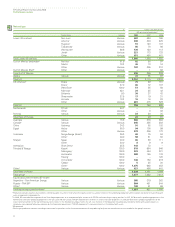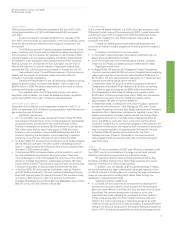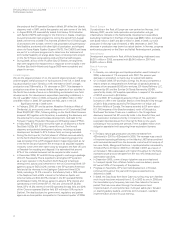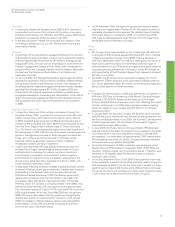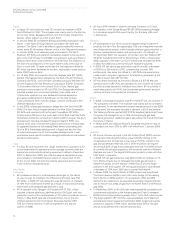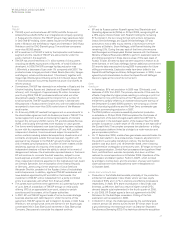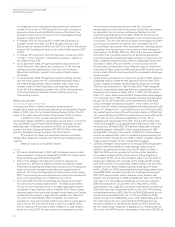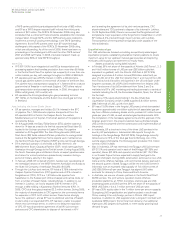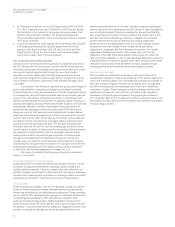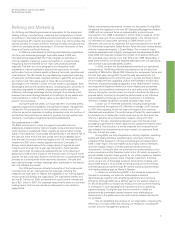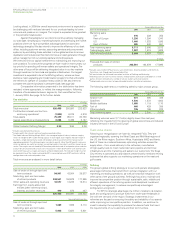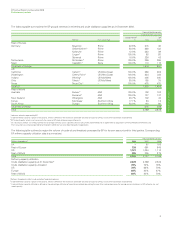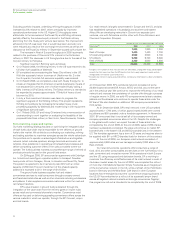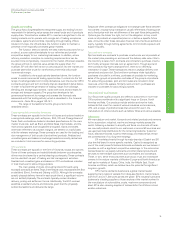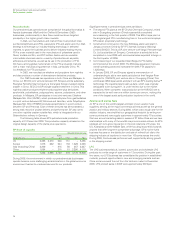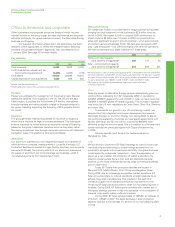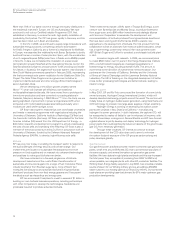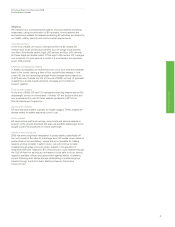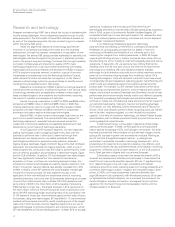BP 2008 Annual Report Download - page 31
Download and view the complete annual report
Please find page 31 of the 2008 BP annual report below. You can navigate through the pages in the report by either clicking on the pages listed below, or by using the keyword search tool below to find specific information within the annual report.
BP Annual Report and Accounts 2008
Performance review
• BP Shipping took delivery of four LNG ships during 2007 and 2008.
The ‘Gem’ class ships can carry 155,000m3 of LNG and are among
the first ships in the industry to be powered by low-emission, fuel-
efficient, diesel-electric propulsion. BP Shipping provides safe,
environmentally responsible marine and shipping solutions in support
of BP group activities.
• In both the Atlantic and Asian regions, BP is marketing LNG using BP
LNG shipping and contractual rights to access import terminal
capacity in the liquid markets of the US (via Cove Point and Elba
Island) and the UK (via the Isle of Grain), and is supplying Asian
customers in Japan, South Korea and Taiwan.
Gas marketing and trading activities
Gas and power marketing and trading activity is undertaken primarily in
the US, Canada, the UK and Europe to market both BP production and
third-party natural gas and manage market price risk as well as to create
incremental trading opportunities through the use of commodity
derivative contracts. Additionally, this activity generates fee income
and enhanced margins from sources such as the management of price
risk on behalf of third-party customers. These markets are large, liquid
and volatile.
In connection with the above activities, the group uses a range of
commodity derivative contracts and storage and transport contracts.
These include commodity derivatives such as futures, swaps and options
to manage price risk and forward contracts used to buy and sell gas and
power in the marketplace. Using these contracts, in combination with
rights to access storage and transportation capacity, allows the group to
access advantageous pricing differences between locations, time periods
and arbitrage between markets. Natural gas futures and options are
traded through exchanges, while over-the-counter (OTC) options and
swaps are used for both gas and power transactions through bilateral
and/or centrally cleared arrangements. Futures and options are primarily
used to trade the key index prices such as Henry Hub, while swaps can
be tailored to price with reference to specific delivery locations where
gas and power can be bought and sold. OTC forward contracts have
evolved in both the US and UK markets, enabling gas and power to be
sold forward in a variety of locations and future periods. These contracts
are used both to sell production into the wholesale markets and as
trading instruments to buy and sell gas and power in future periods.
Storage and transportation contracts allow the group to store and
transport gas, and transmit power between these locations. The group
has developed a risk governance framework to manage and oversee the
financial risks associated with this trading activity, which is described
in Note 28 to the Financial statements on pages 142-147.
The range of contracts that the group enters into is described
below in more detail:
Exchange-traded commodity derivatives
Exchange-traded commodity derivatives include gas and power futures
contracts. Though potentially settled physically, these contracts are
typically settled financially. Gains and losses, otherwise referred to as
variation margins, are settled on a daily basis with the relevant exchange.
Realized and unrealized gains and losses on exchange-traded commodity
derivatives are included in total revenues for accounting purposes.
OTC contracts
These contracts are typically in the form of forwards, swaps and options.
Some of these contracts are traded bilaterally between counterparties;
others may be cleared by a central clearing counterparty. These contracts
can be used for both trading and risk management activities. Realized and
unrealized gains and losses on OTC contracts are included in total
revenues for accounting purposes. Highly developed markets exist in
North America and the UK where gas and power can be bought and sold
for delivery in future periods. These contracts are negotiated between two
parties to purchase and sell gas and power at a specified price, with
delivery and settlement at a future date. Typically, these contracts specify
delivery terms for the underlying commodity. Certain of these transactions
are not settled physically. This can be achieved by transacting offsetting
sale or purchase contracts for the same location and delivery period that
are offset during the scheduling of delivery or dispatch. The contracts
contain standard terms such as delivery point, pricing mechanism,
settlement terms and specification of the commodity. Typically, volume
and price are the main variable terms. Swaps can be contractual
obligations to exchange cash flows between two parties. One usually
references a floating price and the other a fixed price, with the net
difference of the cash flows being settled. Options give the holder the
right, but not the obligation, to buy or sell natural gas products or power at
a specified price on or before a specific future date. Amounts under these
derivative financial instruments are settled at expiry, typically through
netting agreements to limit credit exposure and support liquidity.
Spot and term contracts
Spot contracts are contracts to purchase or sell a commodity at the
market price, typically an index price prevailing on the delivery date when
title to the inventory passes. Term contracts are contracts to purchase or
sell a commodity at regular intervals over an agreed term. Though spot
and term contracts may have a standard form, there is no offsetting
mechanism in place. These transactions result in physical delivery with
operational and price risk. Spot and term contracts relate typically to
purchases of third-party gas and sales of the group’s gas production
to third parties. Spot and term sales are included in total revenues, when
title passes. Similarly, spot and term purchases are included in purchases
for accounting purposes.
30




